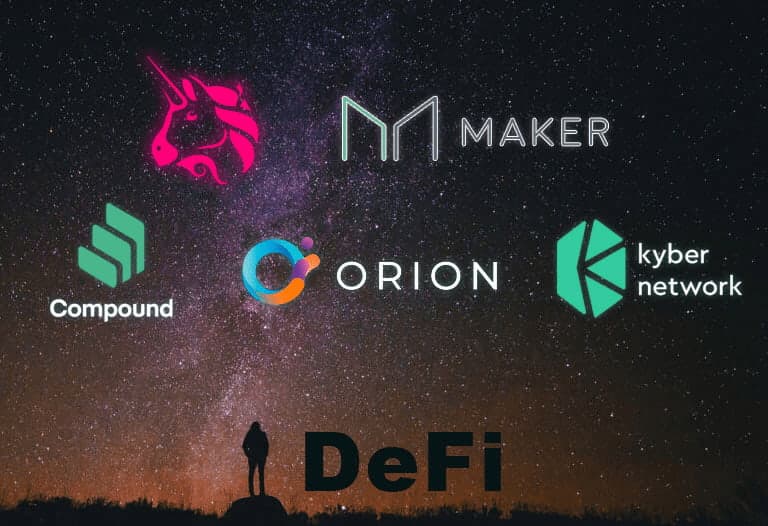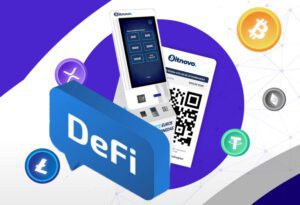
Table of Contents
ToggleDEFI and the challenge of the decentralization of cryptocurrencies
An area of cryptocurrencies that currently attracts enormous attention is the DeFi (Decentralized Finance). It is an ecosystem of financial applications (built on blockchain networks) that use smart contracts, which are automated executive agreements that do not need intermediaries, such as a bank or a lawyer, and they use blockchain technology instead.
The world of cryptocurrencies is expanding at an incessant pace. What started with a simple technology that supports Bitcoin (blockchain) has evolved into an entire industry in its own right.
If you are an avid follower of Bitnovo’s blog, you already know that one of the most interesting features of Bitcoin and most other cryptocurrencies is that they are decentralized, that is, they are not subject to the control of any government or financial institution.
However, as the cryptocurrency space expands its horizons, the original idea of decentralization discussed in the Bitcoin white paper in 2008 continues to weaken.
In fact, with the aim of making the different cryptocurrencies interoperable and obtaining a synchronization between them, solutions in the form of badly planned gateways have been implemented. All of this has made the cryptocurrency space a loosely connected infrastructure, the repercussions of which will be amplified as the use of cryptocurrencies increases in everyday applications.
This is why most of the trading exchanges in the cryptocurrency space are centralized.
This has been the norm so far. Imagine that ironically, the cryptocurrencies, which spoke of economic decentralization, are instead exchanged and stored in centralized wallets. Fortunately, this paradigm is changing since many in the crypto universe are convinced that the era of centralized cryptocurrency exchange must end.
What is the Defi: definition
And this is how DeFi – DECENTRALIZED FINANCE – was born, whose purpose is to create an open source and transparent financial services ecosystem, which is available to everyone and operates without any central authority. Users would retain full control over their resources and interact with this ecosystem through peer-to-peer (P2P) applications and decentralized apps (Ðapps).
So, if the promise of cryptocurrency is to make money and payments universally accessible to anyone, regardless of where they are in the world, the Decentralized Finance (Defi) or Open Finance movement brings this promise a step further.
Decentralized finance can be defined as the fusion of traditional banking services with decentralized technologies such as cryptocurrencies and decentralized applications (Ðapps). Technically, it refers to the combination of all decentralised products and services such as smart contracts, protocols and applications.
Decentralized finance therefore aims to create a financial system open to all and minimizes the need to trust and rely on central authorities, thanks to technologies such as Internet, encryption and blockchain.
There’s a saying in the blockchain space that explains perfectly Defi’s mission: “Don’t trust, verify” .
DeFi, thanks to blockchain technology, allows anyone to verify any transaction that occurs on the blockchain and therefore to take care of its financial welfare, without having to rely on a central authority.
What are the benefits of Defi?
To make you understand the scope of the Defi, we will now explain the main features of Decentralized Finance.
- Permissionless: the blockchain of the Defi system do not need authorization, which allows anyone to access applications on a Defi protocol and to trade on the network.
- Accessibility: anyone with a device like a PC or smartphone and a decent internet connection, from any corner of the world, can join a DeFi network. This characteristic, in particular, certainly gives decentralized financial systems the upper hand over traditional banking systems, since it takes into consideration that slice of the world population that cannot access and use essential banking services.
- Interoperability: Defi is easily compatible with the integration of other applications, so it has the possibility to expand further, offer new services and even develop new financial markets.
- Transparent and Open Source: The code is open source on a Defi system. This means that the code is visible to each user and allows anyone on the network to control it and verify its security and functions, without interfering with the privacy of users. In fact, these are identified by their digital signatures.
What are the potential use cases of the Defi
Among the main cases of use of the Defi we find:
Loans and Crypto loans
P2P (peer-to-peer) lending and lending platforms are one of the most widely used applications of the DeFi system. These are usually simple decentralized applications (Ðapps) that allow to grant loans to individual borrowers or organizations reliably, without any third party interference, and allow lenders to earn interest in the form of cryptocurrencies on the funds they deposit.
Therefore, open and decentralized loans have many advantages over the traditional credit system including:
- Easy access for both lenders and borrowers
- Instant liquidations of funds via smart contracts
- The ability to collateralise digital assets
- Total transparency in the flow of funds
- No credit checks
- Reduced risks
- Flexibility on loan
The DEX Compound platform is a good example of a Defi loan/loan protocol.
Staking
Staking is the process of helping to participate in Proof-of-Stake (POS) blockchain network governance by delegating digital resources to a validation node or by simply holding these digital resources in a compatible portfolio.
When users help protect the blockchain through the staking of resources, they earn rewards that are delivered by the network. Some of the popular stacking assets are Tezos (XTZ), Tron (TRX) and Cardano (ADA).
DEX / Decentralized exchanges
One of the best known use cases of DeFi is DEX. Decentralized exchanges are cryptocurrency exchange platforms that allow all users to perform P2P (peer-to-peer) transactions with each other and control their funds independently and without intermediaries. DEXs provide greater liquidity, safeguard all personal data of users and their funds, and reduce the risks of market manipulation by a considerable margin.
Right now, some of the most popular DEXs in the DeFi world are Yearn.Finance and Curve.fi.
Decentralized insurance
There is currently a range of Defi platforms that offer insurance against any unforeseen (a market crash, a hack, the failure of a smart contract). An example of this is Nexus Mutual.
Unlike traditional insurers, decentralised insurance allows a pool of investors to share the risk with each other in exchange for the insurance premium.
These are platforms built using publicly visible smart contracts, which means that payment deadlines guarantee maximum transparency.
Monetary Banking Services and Stablecoin
As DeFi applications are financial applications, monetary banking services are an obvious use case. These can include issuing stablecoins, mortgages, and insurance.
As the blockchain industry matures, there is more focus on the creation of stablecoin.
Stablecoins are a type of digital asset whose value is pegged to another asset (ex. fiat currencies such as the US dollar (USD) or the euro (EUR)) in order to reduce volatility and keep the price as stable as possible.
As for mortgages, due to the number of intermediaries that need to be involved, the process of obtaining a mortgage is costly and time consuming. With the use of smart contracts, legal fees can be reduced significantly.
Finally, as far as insurance is concerned, when it is managed through blockchain technology, the need for intermediaries could be eliminated and the risk distribution between many participants could be allowed. This could result in lower premiums with the same quality of service.
Payments
The peer-to-peer payment system is one of the basic features of decentralized finance. DeFi payment networks allow all users to negotiate directly with each other, without the need for third parties, creating a convenient financial system for the large part of the world population that is still without banks.
Tokenization
In the specific case of DeFi, a token is a virtual asset issued and managed on a blockchain. Tokenization is a native feature of the Ethereum blockchain, which means it can provide DeFi platforms on the same blockchain with a number of economic benefits.
Digital tokens are a safe way for users on DeFi platforms to hold their asset values and trade without ever risking losing their assets.
DeFi platforms typically offer tokens to users to invest in a particular platform (for example, the Yearn.Finance offers YFI token and Compound distributes the COMP token) giving them in most cases governance powers or the use of certain applications.
Synthetic Assets
Synthetic Assets, in the world of Defi and cryptocurrencies, are designed to mimic the value of other assets, allowing investors to exchange digital and traditional assets while remaining in the cryptographic ecosystem.
In a nutshell, synthetic assets are meant to mimic another investment. They can combine various derivative products such as futures, options or swaps, to simulate an underlying asset (stocks, bonds, indices, commodities, currencies or interest rates).
So, these assets can be wagered as collateral on Defi platforms and have synthetic assets (which are basically cryptographic tokens) minted against them.
Synthetix is, for example, a synthetic resource protocol. For example, a user can save the Synthetix SNX or ETH token as a guarantee on Synthetix and have synthetic resources minted against it.
Yield Farming
Yield Farming (also known as liquidity extraction) is one of the most recent Defi use cases. It consists of blocking digital resources in exchange for rewards which are usually delivered automatically by a smart contract.
One example is OKEx which recently launched yield farming on its Jumpstart platform, allowing users to stake their OKB tokens to mine new digital assets.
Yield Farming is generally considered to be high risk/high return as locked resources can be lost if there is a backdoor or loophole in the farm smart contract, while the generated resources could be useless.
CONCLUSIONS
Whether you are looking for insurance, exchanges, staking solutions or any other type of instrument and financial, chances are you will be able to find a DeFi platform that covers it and is right for you.
The Defi market is small compared to traditional finance, but has undergone a rapid acceleration since last year.
According to data provided by Defi Pulse, more than 3 billion dollars have already been allocated to various platforms, demonstrating that the ecosystem grows in tandem with its use cases.
For this reason it is expected, in the future to come, that the Defi becomes more and more a dominant point of discussion in both traditional and crypto financial circles.




